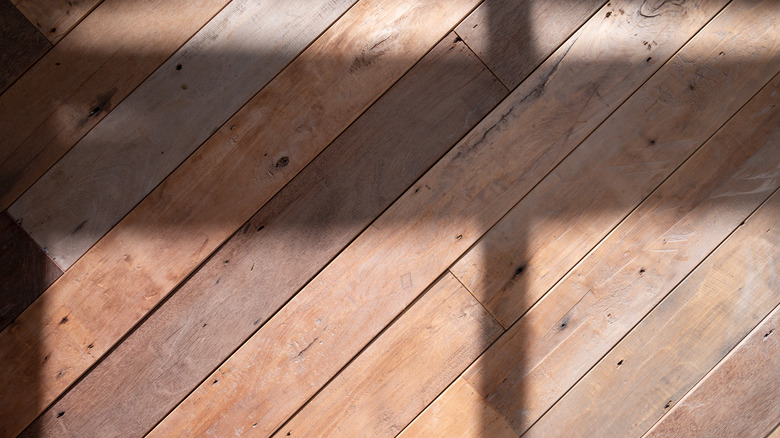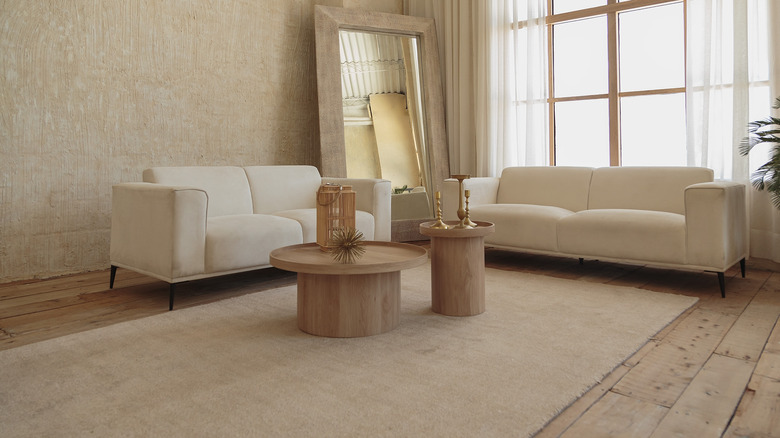Stylish Ways To Work With Uneven Floors
You know what they say: if you can't beat them ... find a way to style them! That's how it goes, right? Well, regardless, the statement definitely applies to crooked, uneven floors. They can be caused by structural or foundational issues that demand extensive, complex interventions to fix. In the long term, repair work is unavoidable, but considering how much it costs to repair sagging floors, it might not be a realistic solution for the time being. This doesn't mean you have to sacrifice style, though. Working around uneven floors can be as simple as picking the right statement rug, placing furniture strategically, choosing the right window treatment, and diverting the eye upwards with stylish lighting and art pieces.
With the right decor, it'll be easier to live with the imperfections until you can repair them, and you might even begin to appreciate them for what they mean. Uneven floors are usually synonymous with history-filled antique homes whose charm should be incorporated by interior design. Historic floors, especially hardwood floors, are one of the vintage home features people love the most for their authenticity and craftsmanship.
How to decorate around uneven floors
Say you've decided to embrace your uneven floors but would still prefer to soften their impact — a good rug is a foolproof solution. Place a neutral, understated rug strategically over problem areas to better blend them into the room, or go the opposite direction by placing a vibrant rug with an eccentric pattern away from awkward angles and dips. With such a bright star of a rug, your faulty floor will no longer be the main character. Large area rugs will turn your unique floorboards into a rustic frame for your space, giving them just enough leeway to add character without being overwhelming.
Another great way to minimize the disharmony of sloping floors is to curate your window treatments carefully. The secret to mapping out the perfect length for your curtains on uneven floors is to opt for a puddled effect that will mask disparate ceiling heights and bring some luxury to your home's antique charm. Floor-to-ceiling curtains also help direct the eye upwards, pulling focus away from the floor.
Play into that trick by enhancing the ceiling and the top half of your walls. Hop on the statement ceiling trend with playful colors and wallpapers or beams and molding. For a more discreet approach, decorate your walls with stunning art, or invest in eye-catching light fixtures. Speaking of the latter, strategically lighting your space can banish crooked floor corners to the shadow world. Go for soft, layered lighting that you can customize to illuminate or veil certain spots.
Picking the right furniture for uneven floors
Picking the right furniture can completely change the look of a room with uneven floors. Experimenting with size and color, for example, can be helpful to draw the eye away from the ground. Make furniture the focal point of your space by picking large pieces that will cover as much surface as possible while capturing the full attention of residents and visitors alike. For smaller spaces, color will also do the job, with one caveat. Loud, bold furniture that hangs near the floor, such as a couch, could have the opposite effect, bringing unwanted curiosity toward stubborn floorboards and tiles. Instead, add pops of color to tall pieces like a kitchen island, bar stools, and shelving.
Another worthwhile avenue is adopting a more cohesive, complementary look that can make characterful flooring seem almost intentional. For this, pick furniture in rustic or industrial aesthetics. Both of these interior design styles celebrate and embrace imperfection, roughness, and a worn, lived-in feeling that pairs well with uneven floors. A cottage-inspired look asks for reclaimed wood, vintage, thrifted pieces, and leather upholstery in earth tones. Industrial interiors integrate many of the same motifs with added metal accents and a preference for darker tones like black, deep green, or maroon. After thoughtfully handpicking your furniture, place it above trouble spots using adjustable feet that will compensate for any slopes. If that's not enough to stabilize the pieces, consider making space in your budget for custom-made pieces.


